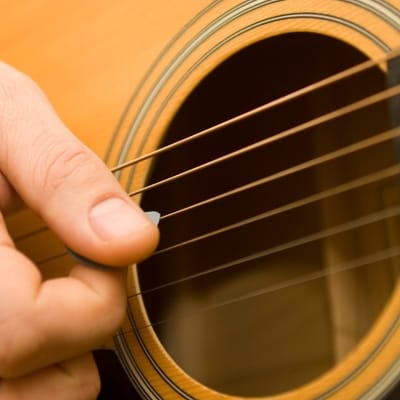How To Use The Pentatonic Scale In Riffs, Licks, and Solos
Read about some real-world examples of how to use the pentatonic scale in your performance!

This article was written by Shawn Leonhardt (Guitar Tricks and 30 Day Singer)!
The pentatonic is the most commonly used music scale across the entire world; almost everyone knows and uses it. Some guitar lessons jump straight to learning this scale over the maj/min scales. Most melodies from many genres and styles follow either a major or minor 5-note scale, and since so many people love it, it’s hard to go wrong when using it! Here are some examples of how to use the pentatonic scale in riffs, licks, and solos in real-world situations.
How the Pentatonic Differs from the Major and Minor Scale
The C major scale is C D E F G A B C with a scale formula of 1 2 3 4 5 6 7, and the pentatonic scale only uses the 1 2 3 5 6, so in C that is C D E G A. If you play a major scale and get to the 4 and 7 you will notice they have more dissonance than the other notes. Music notes and rhythms work because of tension and release, a push and pull that constantly occurs when playing.
By taking the slightly dissonant notes of the 4th and 7th out, we are left with agreeable notes that almost everyone likes. The major pentatonic guitar scale lacks notes that sound off, so it can be played as a solo or melody with hardly any issues or mistakes. We create a minor scale by flattening certain notes like the b3, b6, and b7 degrees of the major scale, so in C that is C D Eb F G Ab Bb. A minor pentatonic scale only uses 5 of those notes with 1 2 b3 5 b7; in a minor song, these notes will usually fit.
Traditional and Popular Songs
Because it is such a staple across the world, it is wise to know the pentatonic inside and out, and the best way is to study traditional, kids', and popular music. The most enduring melodies throughout history are often major pentatonic in nature. The ease of the notes for singing and the lack of dissonance are the reasons for their popularity. If you are humming a song in your head right now that you learned as a toddler, it likely has a pentatonic scale.
On the other hand, most modern blues, metal, rock, and pop will use minor pentatonic scales. They tend to use major chord progressions and then overlay minor or blue notes to create that well-known rock dissonance or the blues scale. There are many complicated jazz and progressive songs out there, but not nearly as many tunes that have simple major or minor pentatonic scale use!

Play Chord Progressions with the Pentatonic for Ideas
The notes in the G major pentatonic scale are G A B D E G so we pick a simple guitar chord progression like the I-IV-V and play them in between the chords. With the chords G major-C major-D major, start on the E string and play 0-0-3-3-5-5 and then hit the G. Next, move to the A string and pick the 4-4-0-0-2-2 before strumming the C chord. Next, play the G, D, and B strings before hitting D and finally form the G chord, but pluck it upward like this; high G, B, G, D, B, D and strum down on the G.
There are many added bass lines to be found when you play the pentatonic scales amongst chord progressions. One famous pentatonic bass line is the boogie-woogie riff, which is made up of a riff of the scale degrees 1, 3, 5, 6, 8. In G-C-D a boogie woogie riff would be like this. Play the notes up and down and then form the next chord shape.
G-G B-B D-D E-E G-G E-E D-D B-B
C-C E-E G-G A-A C-C A-A G-G E-E
D-D F#-F# A-A B-B D-D B-B A-A F#-F# and end on the major chord of G.
By using repeated pentatonic orders, we can work our way through the progression and remember each time we are on a new chord, the scale will fit the root of it. Other common repeated bass line and melody riffs are the 1, 2, 3, 5 and the famous cowboy riff of 1, 5, 6, 5 repeated.
We can also use the minor pentatonic in a chord progression like a power chord sequence of G major-C major-A major with the right scale for each root. Play G5 (355XXX) with G Bb D F, then C5 (X355XX) with C Eb G Bb, and finally an A5 (X055XX) with A C E F and go back to the G. Just like with the major pentatonic anything on the 5 note scale will fit as long as it is the same key.
Instead of just playing our pentatonic scale plain, we will find the most applications when adding them to simple chord progressions and cadences. Besides bass lines, the results you get can also lead to new melodies and catchy riffs.
When Not To Use the Pentatonic
Of course, we will have to watch whether we need to use the major pentatonic or the minor. If it has an overall low or sad feeling, it is likely the minor and usually the major pentatonic will be suitable for bass lines and more upbeat licks. Once you have them in the right place any notes you use will mostly sound OK as long as you aren’t making too big of interval jumps. But when do we know to use a major or another scale?
If we find the song we have is lacking some dissonance or more musicality, there is a chance the pentatonic is not cutting it. With each new note we add to the scale, the intervals will change, and a new element of emotion will be brought into the mix. With these new additions, there will be room for good and bad sounds, each new note makes it harder to find the right one. As you experiment with the pentatonic, try adding extra scale degrees in and listening to see if it works. This ear training method will take you farther than any lesson you have ever had!
The more you play the pentatonic scale, the greater respect you will have for the 4 and 7 scale degrees. In fact, when you play any scale or mode now, it should be clear as to which notes provide most of the feeling and overall vibe. In the real world, the pentatonic is everywhere if you look close enough! Use it in your music for bass lines, riffs, and licks where you want to invoke a popular and well-known response in your listeners.

